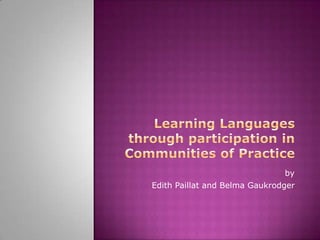Communities of practice
- 1. Learning Languages through participation in Communities of PracticebyEdith Paillat and Belma Gaukrodger
- 2. Confucius circa 450 BCTell me and I forget. Show me and I remember.Let me do and I understand.
- 3. What are multi-user virtual environments?A computer game? - http://en.wikipedia.org/wiki/Comparison_of_MMORPGsSocial networking sites? - http://secondlife.com/An educational tool?
- 4. Why use virtual environments as an educational tool?Sense of presenceSense of freedomAnonymity and possibility to build a personae to build confidenceInteractivity with the environment and othersVirtual travels - no borders except timeStrong socialisation â including voice
- 5. What are Communities of Practice?Kolb, James. P. GeeVygostky, KrashenWenger, Lave
- 6. Koru & KowhaiVLENZ - http://vlenz.edumuve.ac.nz/The Foundation Build â the Hyperdome - http://youtu.be/6tIufh6x5FcThe Birthing Unit - http://youtu.be/BEhK_wjIa74
- 7. EduNationThe Wiki - http://edunation-islands.wikispaces.com/
- 8. SLanguages 2011Emoting â Creative Story-tellingSituated Language Learning in ArcachonKiwi English â English Downunder
- 9. ArcachonThe Blog - http://arcachon-sl.com/2009/01/27/interactivite-arcachon-second-life/A plane crash on Arcachon - http://youtu.be/lY_pIoN4c2A
- 10. ReferencesSchwier, R. A., & Daniel, B. K. (2008). Â Implications of a virtual learning community model for designing distributed communities of practice in higher education. In C. Kimble, P. Hildreth, & I. Bourdon (Eds.), Communities of Practice: Creating Learning Environments for Educators. Vol.2. Charlotte NC: Information Age Publishing, Inc. (pp. 347-365).Wenger, E. (1998). Communities of Practice: Learning, meaning and identity. New York: Cambridge University PressWenger, E., McDermott, R., & Snyder, W. M. (2002). Cultivating communities of practice: Â A guide to managing knowledge. Boston: Harvard Business School Press.
- 11. PresentersEdith Paillat [CybÃĻre Placebo]Edith.paillat@vuw.ac.nzCyber.placebo@gmail.comBelma Gaukrodger [CyberAmberPixelmaid]Belma.Gaukrodger@nmit.ac.nzKiwibelma@gmail.com











![PresentersEdith Paillat [CybÃĻre Placebo]Edith.paillat@vuw.ac.nzCyber.placebo@gmail.comBelma Gaukrodger [CyberAmberPixelmaid]Belma.Gaukrodger@nmit.ac.nzKiwibelma@gmail.com](https://image.slidesharecdn.com/communitiesofpractice-111012020955-phpapp02/85/Communities-of-practice-11-320.jpg)